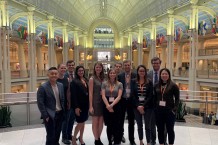Jonah Martin Glick-Unterman
This March, the CTBTO Youth Group attended the Carnegie Endowment’s International Nuclear Policy Conference in Washington, D.C. This year’s conference was particularly anticipated, occurring within weeks of the Hanoi Summit and the first Indian airstrike on Pakistani territory since 1971. The mounting nuclear disquiet was the subject of the conference’s panels and plenums. However, while the discussants outlined expansive objectives in treating with North Korea, China, and Russia, among other powers, their words were chastened by an awareness of the arid political moment.
The conference’s first presentations illuminated the discrepancy between the international community’s maximalist ambitions and political limitations that constrain even modest advances. The U.S. Special Representative for North Korea, Stephen Biegun, offered his take on the direction of U.S.-North Korea negotiations. As he remarked, the international community will continue to demand the final and fully verified dismantlement of North Korea’s biological, chemical, and nuclear arsenals. This vision goes beyond a formal end to nuclear testing pursuant to the CTBT. However, as Under Secretary of State Andrea Thompson determined, in her estimation, the international political environment is not apt for ratifying the CTBT.
This tension between expansive aims and hesitations to adopt more instrumental measures is not new. The disavowal of the Agreed Framework and, more recently, the Joint Comprehensive Plan of Action reflected similar impetuses. These precedents are instructive for formulating confidence building measures that may mollify relations without a remote shade of appeasement. Universal ratification of the CTBT is one such measure. Given improvements in stockpile stewardship technology and prospects for enhanced detection of clandestine tests using the CTBT’s verification regime’s 321 international monitoring stations, it is hard to imagine that ratification of the CTBT could be interpreted as appeasement or a national security liability. The repute of the CTBTO’s Group of Eminent Persons (GEM), which includes experts and diplomats like former United Nations Under-Secretary-General for Disarmament Affairs Nobuyasu Abe, points to the same conclusion.
Ratification by China and the U.S. may put pressure on North Korea to offer concessions over its nuclear program by demonstrating their good faith and continued commitment to Article VI of the NPT. Another measure may be the implementation of an emergency hotline modeled after the five-step hotline specified by the Annex to the Panmunjom Declaration.
It may be difficult to imagine overcoming the current political landscape’s intractable terrain, but politics should not preclude long-term and incremental steps toward a more cooperative and secure world. During conversations with other students and young professionals, including some from Russia and other nuclear-weapon states, I was struck by our common vision of a more cooperative, secure, and peaceful world. Though some from my generation may be jaded by politics, we are more impassioned than ever about humanity, our future, and the fate of our planet.
Following the conference, the CTBTO Youth Group co-hosted a roundtable event at the Arms Control Association on grassroots efforts to advance nuclear test bans. The event began with presentations from Dr Togzhan Kassenova and Daryl Kimball. Dr Kassenova spoke about the humanitarian consequences of nuclear testing, especially in Kazakhstan as a result of Soviet detonations, sharing personal stories about the grassroots advocates in Kazakhstan that prompted the first international movement against nuclear testing in the 1980-90’s. Daryl Kimball presented on the legal and political history of test bans and how he initially became involved in the issue.
The presentations were followed by a discussion amongst the participating members, including Ambassador Nobuyasu Abe, the former United Nations Under-Secretary-General for Disarmament Affairs and CTBTO GEM member. Youth Group members spoke candidly about approaches to grassroots advocacy that could be effective for the “next generation” of nuclear experts, policymakers, and activists and discussed aspects that set this generation apart from previous generations (e.g. social media and being born after the Cold War). The event was a great way to connect young professionals in the nuclear field, allow long-time experts in the field to share their stories of successes and obstacles in grassroots efforts, and discuss feasible approaches to critical issues.
For a full recap of the conference, see Carlos Rodrugiez-Cruz’s video.
Last week, 800+ experts and #NextGen leaders met in Washington to grapple with the most challenging nuclear security issues facing the international community. Here's a recap of the discussions, featuring @rafaelmgrossi, @LauraSHHolgate, and more! #LetsFinishWhatWeStarted pic.twitter.com/xHZ6UYCilZ
— Carlos Rodriguez-Cruz y Celis (@crod_cruz) March 20, 2019
